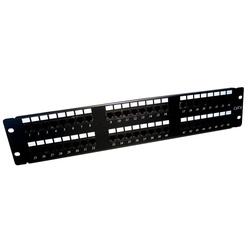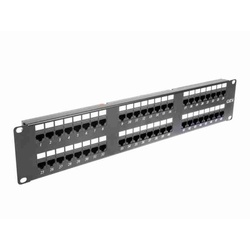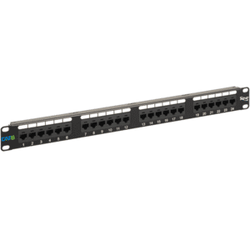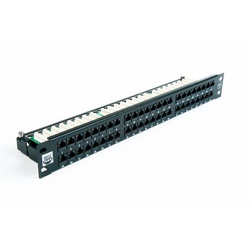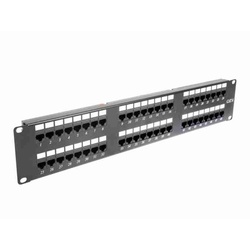
D-link 24port Patch Panel
by D-link
The D-Link 24-port Patch Panel is a networking hardware device used for organizing and connecting multiple network cables in a structured manner. It is designed to facilitate the management and maintenance of network infrastructure, especially in larger-scale setups such as data centers, server rooms, or enterprise networks.
- Port Density: The patch panel provides 24 ports, allowing you to connect up to 24 Ethernet cables. Each port corresponds to a specific network cable, enabling easy and organized cable management.
- Standard Compliance: The patch panel adheres to industry standards, such as the ANSI/TIA-568-C.2 and ISO/IEC 11801, ensuring compatibility with various networking equipment and maintaining signal integrity.
- Keystone Jacks: The ports on the patch panel are usually designed to accommodate keystone jacks. Keystone jacks are small modules that allow you to terminate Ethernet cables, providing a secure and reliable connection.
- Rack-Mountable Design: The patch panel is typically designed to fit into standard 19-inch network racks or cabinets. It features mounting brackets that allow for easy installation and integration within existing network infrastructure.
- Labeling and Identification: The patch panel often includes labeling areas or pre-printed labels for each port, allowing you to identify and manage the connected cables effectively. This labeling simplifies troubleshooting and maintenance tasks.
| SKU | 1170 |
|---|
Reviews
This product does not have any reviews yet.
Add your reviewDescription
D-link 24port Patch Panel
The D-Link 24-port Patch Panel is a networking device designed to efficiently organize and manage network cables in a professional setting. It serves as a central point for connecting multiple network devices, such as computers, switches, routers, and servers.
Key features and characteristics of the D-Link 24-port Patch Panel:
-
Port Density: The patch panel provides 24 ports, allowing you to connect up to 24 Ethernet cables. Each port corresponds to a specific network cable, enabling easy and organized cable management.
-
Standard Compliance: The patch panel adheres to industry standards, such as the ANSI/TIA-568-C.2 and ISO/IEC 11801, ensuring compatibility with various networking equipment and maintaining signal integrity.
-
Keystone Jacks: The ports on the patch panel are usually designed to accommodate keystone jacks. Keystone jacks are small modules that allow you to terminate Ethernet cables, providing a secure and reliable connection.
-
Rack-Mountable Design: The patch panel is typically designed to fit into standard 19-inch network racks or cabinets. It features mounting brackets that allow for easy installation and integration within existing network infrastructure.
-
Labeling and Identification: The patch panel often includes labeling areas or pre-printed labels for each port, allowing you to identify and manage the connected cables effectively. This labeling simplifies troubleshooting and maintenance tasks.
-
Cable Management: The patch panel may offer cable management features, such as cable management arms or slots, to help organize and secure the incoming and outgoing cables. This helps minimize cable clutter and improves airflow within the rack.
-
Durability and Construction: The patch panel is built with sturdy materials and designed to withstand regular use and handling. It ensures long-term reliability and stability for your network connections.
-
Gigabit Ethernet Support: The patch panel is capable of handling Gigabit Ethernet speeds, making it suitable for high-bandwidth applications and environments that require fast and reliable data transmission.
-
Compliance with EIA/TIA Wiring Standards: The patch panel conforms to the EIA/TIA wiring standards, ensuring proper wiring configurations and reducing the risk of signal interference or crosstalk.

